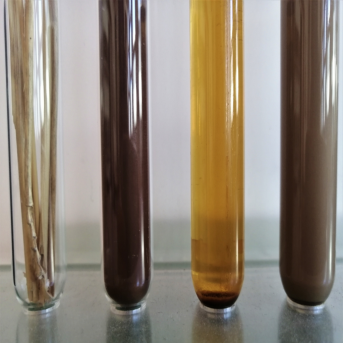IJPB/EUR « Saclay Plant Sciences » (SPS) https://anr.fr/ProjetIA-10-LABX-0040 PhD fellowship (PhD thesis of Adithya Raveendran Thottathil, 2022-2025) – “Flexible lignin-first biorefinery: exploitation of inter- and intraspecies variability of local plant feedstocks” In order to contribute to a circular bioeconomy relying on local feedstocks and sustainable processes, the thesis aims at designing a lignocellulose biorefinery approach considering both lignin structure and feedstocks variability. In the first stage of the study, camelina (Camelina sativa), miscanthus (Miscanthus x giganteus) and maize (three hybrid varieties) were selected according to a multicriteria approach to investigate lignocellulose variability and its influence on lignin isolation. Crop residues from each feedstock were analyzed for their composition in lipids, proteins, carbohydrates and phenolic compounds, as well as for their lignin structure and extractability. The results confirmed that the samples were suitable to investigate the influence of inter-species variability. In a second stage the miscanthus residue was used to test a fractionation process designed to avoid lignin condensation reactions during their depolymerization/dissolution. This process will be further applied to the other feedstocks in order to evaluate its versatility relative to raw materials and produced biomolecules. This study is expected i) to bring new knowledge on lignin structure and reactivities in innovating media, and ii) to pave the way towards a tunable process that is robust to inter- and intraspecies differences and can generate an array of products based on the needs and the availability of feedstocks.
ANR Project 2022-2026 ExPanDe "Pioneering exploration of anaerobic delignification: potentials for lignin valorization in circular bioeconomy" ExPanDe The project aims at investigating the mechanisms/effectors in charge of the anaerobic delignification, in particular in the model bacterium Ruminiclostridium cellulolyticum, as well as in two environmental strains available at LCB (UMR7283 CNRS Laboratoire de Chimie Bactérienne, CNRS, Aix Marseille University). By combining transcriptomic, proteomic, biochemical and mechanistic approaches, the project goal is the discovery of a new class of enzymes/proteins capable to degrade model and industrial lignins without any oxygen. The biotechnological potential of these novel effectors will be assessed in plant biomass delignification processes. The project relies on the complementary expertise of LCB and BBF (UMR 1163 Biodiversité et Biotechnologie Fongiques, INRAE, AMU), and IJPB.
Lignin depolymerization strategy based on polyoxometalates based ionic liquids (PhD thesis of Nour Zeaiter; 2021-2024; codirection with CNRS Institut Lavoisier de Versailles (ILV); Funded by LabexCharm3AT).

Investigation of lignification and other secondary metabolic pathways thanks to the design of models and probes required for imaging or determination of metabolites. A new "emergence" project is jointly designed with GAS team (IJPB) and several labs from the Graduate School Chimie of UP-Saclay (ILV, ICMMO) to work on the labeling of lignins using fluorescent markers. The objectives are: i) to map the lignins, their integration into other biopolymers; ii) to understand how the heterogeneous structures of the cell wall react to environmental and mechanical variations during cellular development and organ growth.
ANR Project 2022-2026 ExPanDe "Pioneering exploration of anaerobic delignification: potentials for lignin valorization in circular bioeconomy" ExPanDe The project aims at investigating the mechanisms/effectors in charge of the anaerobic delignification, in particular in the model bacterium Ruminiclostridium cellulolyticum, as well as in two environmental strains available at LCB (UMR7283 CNRS Laboratoire de Chimie Bactérienne, CNRS, Aix Marseille University). By combining transcriptomic, proteomic, biochemical and mechanistic approaches, the project goal is the discovery of a new class of enzymes/proteins capable to degrade model and industrial lignins without any oxygen. The biotechnological potential of these novel effectors will be assessed in plant biomass delignification processes. The project relies on the complementary expertise of LCB and BBF (UMR 1163 Biodiversité et Biotechnologie Fongiques, INRAE, AMU), and IJPB.
Lignin depolymerization strategy based on polyoxometalates based ionic liquids (PhD thesis of Nour Zeaiter; 2021-2024; codirection with CNRS Institut Lavoisier de Versailles (ILV); Funded by LabexCharm3AT).

Investigation of lignification and other secondary metabolic pathways thanks to the design of models and probes required for imaging or determination of metabolites. A new "emergence" project is jointly designed with GAS team (IJPB) and several labs from the Graduate School Chimie of UP-Saclay (ILV, ICMMO) to work on the labeling of lignins using fluorescent markers. The objectives are: i) to map the lignins, their integration into other biopolymers; ii) to understand how the heterogeneous structures of the cell wall react to environmental and mechanical variations during cellular development and organ growth.

Leader:
Stéphanie Baumberger